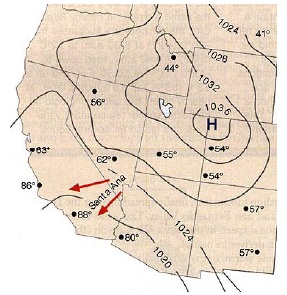Local Scale WindLand - Sea BreezeLocal scale circulation generally operates over a distance of 10 to 100 kilometers. Many local scale winds are created by unequal heating of the earth. For instance, a land - sea breeze is created along coasts where land and water create variations in pressure due to differences in the way these two bodies heat and cool.
Figure 6.15 Land-sea breeze conditions. During the day, land heats more rapidly than water resulting in low pressure forming over land and higher pressure over water. Air moves from over the water toward land in response to the pressure gradient creating a sea breeze. During the evening, the land cools more rapidly than water promoting higher pressure over the land and lower pressure over water. The pressure gradient induces the air to flow from the land toward the water as a land breeze. Mountain-Valley WindsDuring the daytime, mountain slopes warm causing the air over the slope to be warmer than the air over the valley at the same elevation. Warming the air causes it to rise upwards creating a valley wind. During the evening, the air chills due to a loss of surface energy to space. The cool dense air moves down slope as a mountain wind. ChinookThe term "Chinook" is a old Native American word that means "snow eater". A chinook is a warm dry wind on the leeward side of a mountain. As air descends the leeward side of a mountain it is compressed and adiabatically heated. Warming the air causes the saturation point to increase resulting in a decrease in its relative humidity (assuming the water vapor content remains the same). The newly created warm and dry wind moves down slope quite rapidly, and during the Spring causes substantial melting of mountain snow packs. Santa Ana WindsSanta Ana winds are another warm and dry wind. Over plateau regions in the desert region of the United States, high pressure pushes air off the plateaus forcing the air into narrow mountain valleys. As the air is forced through the valley it is compressed and warms. As the air warms the saturation point rises and its relative humidity drops. Santa Ana winds have been responsible for fueling wildfires in southern California. The dry wind desiccates the surface and whips wildfires into raging fire storms.
Figure 6.16 Weather conditions for Santa Ana winds
|


